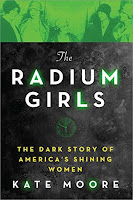 The full title of today's selection is The Radium Girls: The Dark Story of America's Shining Women. In it, Kate Moore tells the true story of the women who worked as dial-painters in America during World War I. It was a somewhat prestigious, well-paying, and often fun job for young women in the early 1900s. The book is full of stories of the girls getting along well with each other as they sat at their stations and painted tray after tray of dials using a paint mixture made from radium. Of course, those of us living in the 21st century are well aware of the dangers that can come from being exposed to radium, even to a small amount for a short period time. But during WWI, radium was still being hailed as a miracle substance that was perfectly safe to be around, though there are some people who knew the truth.
The full title of today's selection is The Radium Girls: The Dark Story of America's Shining Women. In it, Kate Moore tells the true story of the women who worked as dial-painters in America during World War I. It was a somewhat prestigious, well-paying, and often fun job for young women in the early 1900s. The book is full of stories of the girls getting along well with each other as they sat at their stations and painted tray after tray of dials using a paint mixture made from radium. Of course, those of us living in the 21st century are well aware of the dangers that can come from being exposed to radium, even to a small amount for a short period time. But during WWI, radium was still being hailed as a miracle substance that was perfectly safe to be around, though there are some people who knew the truth.Genre, Themes, History: This is a nonfiction book that gives detailed accounts of the lives of several women who worked as dial-painters in early 20th century America. These women went to work in one of two cities, either Orange, New Jersey or Ottawa, Illinois, in factories that specialized in the production of clock faces painted with the mysterious and glowing substance of radium. They had been told the substance was safe, so there were little to no safety precautions in place to protect the girls' health. In fact, they were told it was so safe that the technique of lip pointing was employed to make sure the brushes they used achieved the perfect fine-pointed tip. Basically, to keep the hairs of the brush from spreading, which would make them unable to achieve the fine lines necessary for dial-painting, the girls would put the brushes in their mouths before dipping them into the paint. And because radium often made the hairs on the brushes stiff and hard to work with, the girls would put them in their mouths several times throughout their shift. Although the regular exposure to the radium would be enough to cause problems, the fact that the girls were putting the radium covered brushes into their mouths led to serious health concerns that many of them would never recover from. Most often the substance attacked their mouths and jaws, often moving to bones and joints throughout their body. As more and more women fell sick, and people were finally realizing why, the women would not only fight for their lives, but also against the companies that helped put them in this terrible position. Cases that came out of both Orange and Ottawa would set precedents regarding worker's rights and holding companies accountable for occupational hazards.
My Verdict: There are other books and articles that talk about the dial-painters of America and what they went through as a result of the work they did, but what Moore wanted to do was write a book that told a story specifically from the women's point of view, and I think that is what makes this book so interesting and engaging. It does not simply list facts and figures, names and dates, court cases and cities. Instead, Moore goes into the women's daily responsibilities as dial-painters, who they married, how they lived, what their hometowns were like, and later, how each one suffered, what treatments they endured, how they found a lawyer (if they found one at all), and ultimately how they died. Though it is a true story, it does not read like one, and often felt more like political intrigue or a courtroom drama. But these were real people who endured real suffering, and had to fight real corporations who were more interested in making money than in keeping their workers safe. It is an interesting story that was often hard to read, but ultimately it was worth it to learn about a fascinating piece of American history.
Favorite Moment: When a high-profile lawyer from Chicago decides to take on the women's case for free.
Favorite Character: Grace Fryer was perhaps the most fierce of the group from Orange who decided to sue the United States Radium Corporation. She often led the charge when confronted with a new barrier and was never intimidated into backing down.
Recommended Reading: I recommend The Train to Crystal City by Jan Jarboe Russell, which tells the story of the only family internment camp in American during World War II.
No comments:
Post a Comment